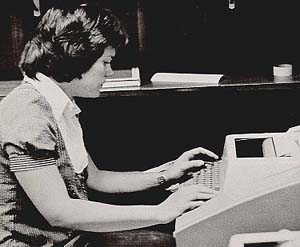First Computer: Smedley
 As early as 1962, the mathematics department offered a digital computing course taught by adjunct professor A.R. Brown from Ent Air Force Base in Colorado Springs. Another adjunct professor, Richard Vogel, who gained computing experience at Los Alamos, stepped in to carry the course for a few more years. Computer time was booked wherever they could find it until the college officially signed on to the General Electric Time-Sharing Service in 1967. This service allowed a terminal on campus to connect via phone lines to a mainframe computer in Phoenix, Arizona.
As early as 1962, the mathematics department offered a digital computing course taught by adjunct professor A.R. Brown from Ent Air Force Base in Colorado Springs. Another adjunct professor, Richard Vogel, who gained computing experience at Los Alamos, stepped in to carry the course for a few more years. Computer time was booked wherever they could find it until the college officially signed on to the General Electric Time-Sharing Service in 1967. This service allowed a terminal on campus to connect via phone lines to a mainframe computer in Phoenix, Arizona.
Then Wilson Gateley and Gary Bitters from the mathematics department teamed up to write a proposal for a college computer. Although they explained that the mathematics department would be teaching some computer science courses, the bulk of the proposal addressed administrative advantages of a campus computer system. The first proposal in 1968 faded away, but the second revised attempt presented in 1971 met with success. The college purchased a Hewlett Packard 2000C digital computer. (Model 2000A had 16K RAM and a 350K disk (!); model 2000C was an upgrade.) By 1972 there were 17 terminals (mostly mechanical teletypes - see photo) connected to the computer which now was affectionately called "Smedley".
Wilson Gateley became the first computer center director (half time) and Robin Jeffries was the first college programmer. The mathematics department continued to teach digital computing; to help spark computing across campus Gary Bitters had earlier written an introduction to the BASIC language. The task of teaching the computing course soon fell to Richard Paine who met his more advanced students at midnight when they could safely disengage any administrative tasks on the computer and really learn how the machine worked.
After Gateley left the college in 1975 and William Turner (Assistant Dean of the College) stepped in to run the computer center for awhile, another mathematician Daniel Sterling served as director of the computing center for one year in 1978.
Computers age rapidly, and Smedley just about lasted to the end of the decade when the college replaced it with a Burroughs B6805. The nickname "Mnemosyne" was only half-hearted and the new machine never captured the imagination of the campus. Instead, it focused the tension between academic and administrative uses of the computer. The eighties soon ushered in the age of micro-computers and the college embraced them in 1983 when they purchased Texas Instruments MicroComputers which served admirably until gradually giving way to the PC clones and Macs.


